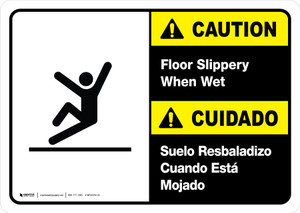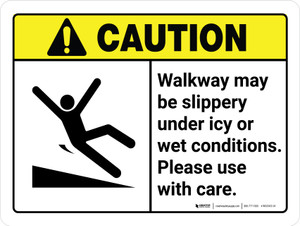Wet floors are a slipping hazard and a legal liability for business owners. Slipping hazards cause numerous slips and falls at workplaces annually, resulting in potentially high medical costs, lawsuits, as well as lost time for both the employer and their employees. This not only decreases productivity and efficiency levels within work processes, but it also is a sign of an unsafe workplace.
Minimize this risk by protecting your employees and your business with posted warnings. Ensure your message is clear when using wet floor signs, wet floor cones, or other signage. Overall, placing extra visual communication around the area can do nothing but minimize damages and keep your workers safer during their time on the work floor.
Improve Safety and Service with Wet Floor Signs
Providing the safest environment for both visitors and employees is essential for maintaining exceptional service. Managing hazardous areas with visual warnings can do just that. By putting out safety signage about slippery surfaces, those people will be able to avoid potentially serious injuries not only that but placing this type of signage out can help you stay both OSHA and ANSI compliant!
Shop below for wet floor signs and labels for your establishment. Choose the signs that will work best for your application. Keep in mind that you need to alert people to wet surfaces before they enter hazardous areas.
Businesses that Benefit from Wet Floor Signs
All businesses can benefit from using slippery when-wet signs! For example, restaurants mop up spills, warehouses clean floors, and slippery outdoor spaces experience inclement weather. Use these ANSI-compliant caution signs to protect your business and maintain hazard management practices.
Common Materials Used for Wet Floor Signs
With Creative Safety Supply as your supplier for wet floor signs, you'll find adhesive signs to use on floors that can withstand wet, industrial conditions. There are cones and A-frame signs available for easy mobility. We have options for mounted wall signs or wall signs with adhesive backing. Lastly, of course, there are labels available, our company's specialty.
All our sign and label options are made to last in environments that take a beating when it comes to industrial machine traffic, foot traffic, water, heat, and outdoor conditions. Choose us and you won't be replacing wet floor signage for a while.
Custom Wet Floor Signs Available
Don't see what you're looking for? Get in touch! We can customize floor signs and wall signs to meet your specifications, just call us at 1-866-777-1360 or email us at info@creativesafetysupply.com. The other option would be to use one of our custom sign builders. Choose the logos, graphics, text, and colors of your choice.












































